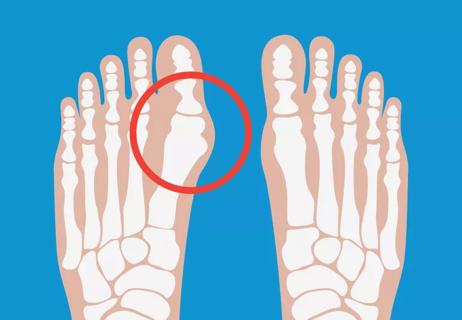Warm soaks, shoe inserts may give you pain relief

Whether it’s sandal season or boot season, you may be thinking it’s time to do something about that bunion jutting out at the base of your big toe.
Advertisement
Cleveland Clinic is a non-profit academic medical center. Advertising on our site helps support our mission. We do not endorse non-Cleveland Clinic products or services. Policy
Doctors call that bunion hallux valgus. It forms when the bone or tissue at the joint at the bottom of the big toe moves out of place. Years of abnormal motion and pressure on the joint forces the big toe to bend toward the others, which causes an often-painful bunion on the joint.
This joint at the base of the big toe carries much of your weight while walking, so bunions can cause severe and constant pain. The joint may become so stiff and sore that shoes are painful to wear.
Bunions often run in families, but they also can be the result of the way we walk or the shoes we wear, says podiatrist Georgeanne Botek, DPM, Head of the Section of Podiatry.
Women develop bunions far more often than men, Dr. Botek says, especially as they get older.
People with flexible joints seem to tolerate their bunions more. But others with stiff joints or arthritis usually have more trouble with their bunions and might develop pain earlier, she says.
If you develop a bunion, talk to your family doctor. He or she may refer you to a podiatrist who diagnoses and treats conditions of the foot, ankle and related structures of the leg.
Bunions are permanent unless surgically corrected. But there are some measures you can take to be more comfortable or to slow a bunion’s progression, says podiatrist Dina Stock, DPM.
Advertisement
“For many people, it may simply be a matter of wearing properly fitting shoes,” she says. “Be sure to choose low-heeled, comfortable shoes that provide plenty of space for your toes and the widest part of your foot.”
Dr. Stock says these seven approaches may relieve the pain and pressure on the toe joint:
Some people are interested in treating their bunions by stretching the feet to realign the toes, or using devices such as toe spacers or bunion splints, Dr. Botek says. Often though, the device is like a pair of eyeglasses – when you take it off, the benefit is gone.
“It won’t completely realign your toe permanently,” Dr. Botek says.
If your bunion is very painful, your podiatrist may recommend surgery. “First do surgery on your shoes,” Dr. Botek states. “If pain persists for more than a year, it may be time to consider bunion surgery, but most patients will have bunions and pain on and off for years before electing for surgery.”
Your doctor also may recommend surgery because bunions can result in other painful foot problems, such as hammertoes, bursitis, a bunion below the little toe, or pain in the balls of your feet, Dr. Botek says. Surgery can be done on mild or severe cases.
When Should I Have Surgery for My Bunions?
“When patients come in at an older age, usually it’s because the bunion is causing other problems,” Dr. Botek says. “For these patients, the pain is more constant or is creating problems with the second toe.”
The goal of surgery is to relieve pain and return the big toe to its correct position. A surgeon puts bones, ligaments, tendons and nerves back into correct order, and removes the bump.
There are more than 150 types of bunion surgery, but surgeons typically choose one from about a half-dozen commonly used procedures, Dr. Botek says.
Advertisement
Learn more about our editorial process.
Advertisement

The short answer from an orthopaedic surgeon

Pick shoes that make your feet happy and are good for your overall health

Most recommended precautions center around minimizing bruising or swelling

Even one drink can have an impact on your cognitive function leading to slurred speech, blurred vision and impaired memory

Understand who may (and may not) benefit

Lorem ipsum dolor sit amet. Et odio Quis vel ipsam omnis eum alias deleniti et placeat impedit non voluptas galisum hic autem enim et cupiditate aliquid. Est beatae quidem non facilis autem ut commodi nisi aut tempore rerum et dolores voluptatem cum enim optio id sapiente quasi. Ad laboriosam officiis 33 cupiditate sequi ea voluptatum consectetur qui necessitatibus voluptate et quasi doloremque et facere explicabo quo explicabo officia

Type 2 diabetes isn’t inevitable with these dietary changes

Applying a hot or cold compress can help with pain